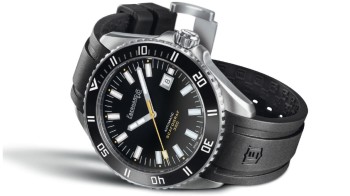It’s an oft-forgotten model and yet is one of the most winsome dive watches in fine watchmaking. Think about its preferred environment — the sea — and the first names that come to mind are better-known players in the sector such as Rolex, Blancpain, and Panerai. These firms are so prominent that people tend to think they have the monopoly on dive watches. Far from it: Eberhard & Co.’s Scafograf, designed in La Chaux-de-Fonds, has been around since 1959!
A Creative Decade
At that time, diving was undergoing far-reaching change, expanding from mainly military purposes to professional applications before becoming recreational, too. The most emblematic dive watches date back to that time: Blancpain’s Fifty Fathoms (1953) and the Rolex Submariner (1953), followed soon afterwards by the Doxa Sub (1964) and Seiko’s Prospex (1968). Amidst this four-star constellation came the Scafograf (1959).

A Illustrious history
The timepiece didn’t emerge out of thin air. As early as 1921, Eberhard & Co. patented the Calotte Patrouille, a cover that protects watch movements from dust and humidity. In a similar vein, the firm went on to set up a department especially dedicated to dive watches, producing a few military timepieces before World War II (e.g. the Mod. 1077, Cal. 1050).
Sales were not long in coming: by the late 1950s, Eberhard & Co. was in a position to launch its Scafograf collection. The story had begun, with the 35mm Scafograf 100 in 1959, the 38mm Scafograf 200 later that same year, the Scafograf 300 in 1964 (42.5mm), the Scafograf 400 in 1969 (40mm) and the Scafograf 1000 in 1983 (also 40mm). The saga came to an end the year after that, in 1984, with the automatic Scafograf.
This amazing little dive watch survived for almost three decades, from 1959 to 1984, demonstrating remarkable adaptability — not to mention awesome resistance in the face of the quartz crisis that swept through the mechanical watch industry from the early 1970s onwards.
Making a comeback
In 2016, the Scafograf returned to the spotlight under the leadership of the brand’s energetic CEO Mario Peserico. The new Scafograf 300 is a genuine self-winding mechanical dive watch, sporting a 43-millimetre diameter steel case, a ceramic unidirectional rotating bezel with luminous markings on the 15-minute timer, a convex sapphire crystal and a helium safety valve at 9 o’clock for saturation diving. It complies with every detail of the ISO 6425 specifications, qualifying it for certification as a genuine dive watch, with an engraved starfish on the caseback serving as a reminder of this status. Many of the period watches are still incredibly affordable — although the prices of older models of this little gem are starting to rise rapidly.
This year GMT Magazine and WorldTempus have embarked on the ambitious project of summarising the divers watch since 2000 in The Millennium Watch Book - Divers watch, a big, beautifully laid out coffee table book. This article is an extract. The Millennium Watch Book - Divers watch is available in both French and English here:






